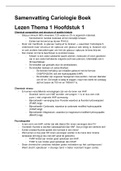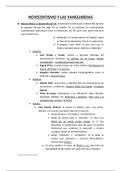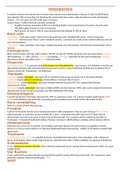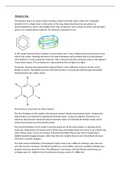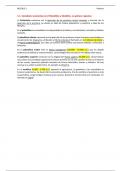BIOCHEMISTRY – LECTURE THREE PART TWO
cell membranes
Every cell in your body is surrounded by a membrane. They are required for
integrity and as a barrier to the external environment. Many organelles are also
membrane bound. The selective nature of the membrane boundary is
fundamental to many cells and organelles function. A biological membrane
consists of lipids, proteins and carbohydrates. It is described as a fluid mosaic as
it is made from different molecules which can move. The most fundamental
aspect of a biological membrane is that it is a phospholipid bilayer. It consists of
two layers of phospholipids, with the hydrophilic heads facing the aqueous
environment of either the inside or outside of the cell. The hydrophobic fatty acid
tails face each other, creating a hydrophobic core. This bilayer will form
spontaneously in an aqueous environment due to the hydrophobic nature of the
fatty acid tails. There are three main types of lipids in the membrane –
phospholipids, glycolipids and cholesterol.
Phospholipids – they have a phosphate head which is hydrophobic and
linked to the glycerol part of the phospholipid. It is to the glycerol
molecule that the phosphate group and fatty acid tails are linked. The
fatty acid tails are hydrophobic and can be saturated or contain double
bonds (unsaturated) which influences the shape and fluidity of the lipid.
There are variations on phospholipids, many with important functions.
There can be serine, choline or ethanolamine on the phosphate group. The
phospholipid is amphipathic, it has a two-sided nature, the hydrophilic
phosphate head and hydrophobic fatty acid tail.
Glycolipids – they have a similar structure to phospholipids except they
have a carbohydrate head on the glycerol body instead of a phosphate
group. They (alongside glycoproteins) are important for cell-cell
recognition, including being the source of the ABO blood antigens.
Cholesterol – it has an amphipathic nature, due to the presence of a
hydrophobic saturated hydrocarbon tail and a tiny polar head due to the
presence of a hydroxyl group. It has a vital role in cell membranes, in
regulating the fluidity of membranes. The more cholesterol that is packed
in, the less fluid the membrane as it fills gaps caused by kinks and bends
in unsaturated fatty acid tails.
Membrane proteins can be categorised by their interaction with the membrane.
Integral proteins penetrate the membrane to the fatty acid core, most are
transmembrane but some do not penetrate all the way through. Transmembrane
proteins pass through the entire membrane, and have cytosolic and extracellular
facing sides. Peripheral proteins can be external or internal, covalently linked to
lipid, or indirectly linked to other membrane proteins. Most transmembrane
proteins have an alpha helical secondary structure, some cross only once –
typically receptors and signal transducers. Some cross many times and can
create a channel, the majority of amino acids interacting with the fatty acids are
hydrophobic but the amino acids away from the fatty acid chains are hydrophilic,
creating a channel for water to move through. Less common is a beta barrel
motif, although the amino acids in contact with the inside of the membrane are
hydrophobic, the internal facing amino acids may be hydrophilic.
cell membranes
Every cell in your body is surrounded by a membrane. They are required for
integrity and as a barrier to the external environment. Many organelles are also
membrane bound. The selective nature of the membrane boundary is
fundamental to many cells and organelles function. A biological membrane
consists of lipids, proteins and carbohydrates. It is described as a fluid mosaic as
it is made from different molecules which can move. The most fundamental
aspect of a biological membrane is that it is a phospholipid bilayer. It consists of
two layers of phospholipids, with the hydrophilic heads facing the aqueous
environment of either the inside or outside of the cell. The hydrophobic fatty acid
tails face each other, creating a hydrophobic core. This bilayer will form
spontaneously in an aqueous environment due to the hydrophobic nature of the
fatty acid tails. There are three main types of lipids in the membrane –
phospholipids, glycolipids and cholesterol.
Phospholipids – they have a phosphate head which is hydrophobic and
linked to the glycerol part of the phospholipid. It is to the glycerol
molecule that the phosphate group and fatty acid tails are linked. The
fatty acid tails are hydrophobic and can be saturated or contain double
bonds (unsaturated) which influences the shape and fluidity of the lipid.
There are variations on phospholipids, many with important functions.
There can be serine, choline or ethanolamine on the phosphate group. The
phospholipid is amphipathic, it has a two-sided nature, the hydrophilic
phosphate head and hydrophobic fatty acid tail.
Glycolipids – they have a similar structure to phospholipids except they
have a carbohydrate head on the glycerol body instead of a phosphate
group. They (alongside glycoproteins) are important for cell-cell
recognition, including being the source of the ABO blood antigens.
Cholesterol – it has an amphipathic nature, due to the presence of a
hydrophobic saturated hydrocarbon tail and a tiny polar head due to the
presence of a hydroxyl group. It has a vital role in cell membranes, in
regulating the fluidity of membranes. The more cholesterol that is packed
in, the less fluid the membrane as it fills gaps caused by kinks and bends
in unsaturated fatty acid tails.
Membrane proteins can be categorised by their interaction with the membrane.
Integral proteins penetrate the membrane to the fatty acid core, most are
transmembrane but some do not penetrate all the way through. Transmembrane
proteins pass through the entire membrane, and have cytosolic and extracellular
facing sides. Peripheral proteins can be external or internal, covalently linked to
lipid, or indirectly linked to other membrane proteins. Most transmembrane
proteins have an alpha helical secondary structure, some cross only once –
typically receptors and signal transducers. Some cross many times and can
create a channel, the majority of amino acids interacting with the fatty acids are
hydrophobic but the amino acids away from the fatty acid chains are hydrophilic,
creating a channel for water to move through. Less common is a beta barrel
motif, although the amino acids in contact with the inside of the membrane are
hydrophobic, the internal facing amino acids may be hydrophilic.


